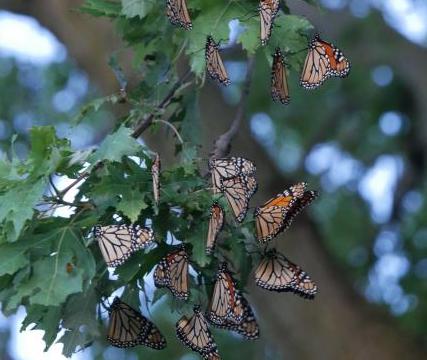
Date: 09/16/2019
Number: 300
After several evenings of a few visitors here and there, tonight marked the first night of big numbers. They started filtering in around 5:00 p.m. with peak numbers showing up around 6:30 p.m. Estimate at least 300, but groups are scattered amongst the many evergreens so totals are hard to tell. GREAT to have them back for a nightly visit and looking forward to tomorrow night to see if numbers hold.
Editor's note: contacted observer for more details on this sighting
1. The first large roost formed on Monday, September 16th.
2. The Monarchs who congregated on Monday night were quick to roost in groups. We live on one acre of land and it is almost entirely covered by either deciduous or evergreen trees. We noticed last year during the roost that the Monarchs have a couple of 'favorite' places so we always began our searches there once we saw them filtering in.
Large clumps were easy to spot so we did actual counts of their size. This would routinely be around 20 -30 members. We would then take note of smaller groups and single visitors and roughly add those numbers in. The reason I mention about the number of trees we have is because there is so much canopy to survey that I know we are underestimating numbers. It's just too tricky in the evening twilight to see them all. We always get out early the next morning to see if there were any groups that we overlooked the night before. So numbers based on actual counts plus a small estimate of stragglers.
3. I am happy to report that our yard is slowly becoming one big nectar source. I have dedicated about 1/4 of my yard to a naturalized flower area that contains milkweed, coneflower, rudbeckia, daisy, salvia, Russian sage, goldenrod, phlox, and soon to have liatris. Also, while we are surrounded on three sides by farm fields, there is a drainage ditch running along the fourth and it's banks are filled with all sorts of indigenous plants (as well as being a calm water source).
4. Our yard is located in a floodplain so overnight temperatures are always a degree or two cooler than surrounding areas. Monday night got down to 60 degrees F, with lows the rest of this week ranging from 57 to 63 degrees F.
5. On Monday night the breeze was light and from the ENE at around 5 mph. The light to calm wind conditions have continued through the week and have ranged from calm to maybe 5 mph around the time the Monarchs settle in. Daytime breezes were a bit higher, but never exceeding 7 - 10 mph. Wind direction has been from the east, to briefly from the south and east, to almost calm last night. The yard is completely sheltered from the wind with the north and west sides ringed with large arborvitae, white pine and Norway spruce. The east side is home to a large silver maple, a large bald cypress and a hackberry tree. Crabapple and Cleveland pear trees run along the south with assorted others throughout the yard. Late arrivals seem to prefer the maple and cypress on the east side of the yard, while the typical favorite spot is tucked into the northwest corner where the arbs and spruces come together. Less roosting in the evergreens this year as a whole and more in the deciduous trees; especially the silver maples.
Bement, IL
Latitude: 39.9 Longitude: -88.6
Observed by: Thomas
Contact Observer
The observer's e-mail address will not be disclosed.
Contact will be made through a web-based form.